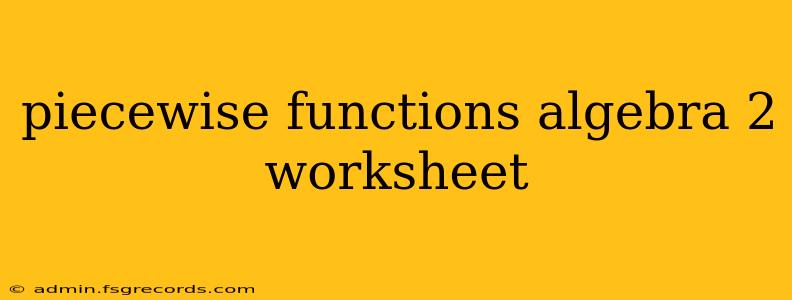Piecewise functions might seem intimidating at first glance, but with a structured approach and some practice, they become manageable and even enjoyable. This guide serves as your comprehensive companion to tackling piecewise function worksheets in Algebra 2, providing clear explanations, practical examples, and strategies for success. We'll break down the key concepts, delve into common problem types, and offer tips to master this important topic.
Understanding Piecewise Functions
A piecewise function is defined by multiple sub-functions, each applicable over a specific interval of the domain. Think of it as a collection of different functions stitched together to create a single, more complex function. The key is identifying which sub-function to use based on the input value (x).
Key Components:
- Sub-functions: These are the individual functions that make up the piecewise function. They can be linear, quadratic, absolute value, or any other type of function you've encountered in Algebra 2.
- Intervals: These specify the domain values for which each sub-function is valid. They are often expressed using inequalities (e.g., x ≤ 2, x > 5) or interval notation (e.g., (-∞, 2], (5, ∞)).
Example:
Let's consider a simple piecewise function:
f(x) = {
x + 1, if x < 2
x² - 3, if x ≥ 2
}
This function behaves differently depending on the value of x:
- If x is less than 2, we use the function
f(x) = x + 1. - If x is greater than or equal to 2, we use the function
f(x) = x² - 3.
Common Piecewise Function Problems in Algebra 2 Worksheets
Algebra 2 worksheets often test your understanding of piecewise functions in several ways:
1. Evaluating Piecewise Functions
This involves substituting a given x-value into the appropriate sub-function based on its interval.
Example: Find f(3) for the function above.
Since 3 ≥ 2, we use the second sub-function: f(3) = 3² - 3 = 6.
2. Graphing Piecewise Functions
Graphing requires careful attention to the intervals. Each sub-function is graphed only within its specified domain. Pay close attention to whether the endpoints are included (closed circle) or excluded (open circle).
3. Finding the Domain and Range
The domain is the union of the intervals defined for each sub-function. The range is determined by examining the output values of each sub-function within its interval.
4. Solving Equations Involving Piecewise Functions
This involves determining which sub-function to use based on the context of the equation and then solving for x.
5. Writing Piecewise Functions from Graphs or Descriptions
This tests your ability to synthesize information and express it mathematically. Carefully analyze the graph or description to determine the sub-functions and their corresponding intervals.
Tips for Mastering Piecewise Functions
- Organize your work: Clearly label each sub-function and its interval. This helps avoid confusion and errors.
- Practice regularly: The more you practice evaluating, graphing, and solving problems involving piecewise functions, the more comfortable you'll become.
- Use visual aids: Graphing the function can significantly improve your understanding of its behavior and help identify key features like discontinuities.
- Break down complex problems: If a problem seems overwhelming, break it down into smaller, more manageable steps.
Conclusion: Conquer the Challenge
Piecewise functions are a crucial topic in Algebra 2. By understanding the core concepts, practicing regularly, and employing effective strategies, you can confidently tackle any piecewise function worksheet and build a strong foundation for future mathematical endeavors. Remember, practice is key—so grab that worksheet and start conquering those piecewise functions!

